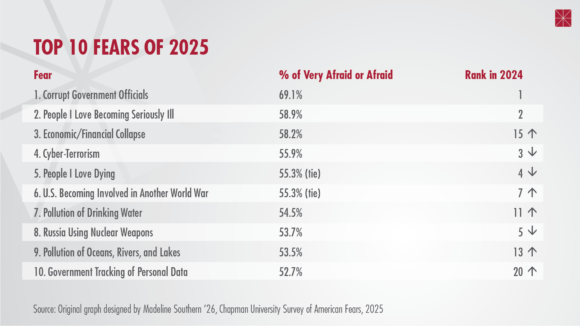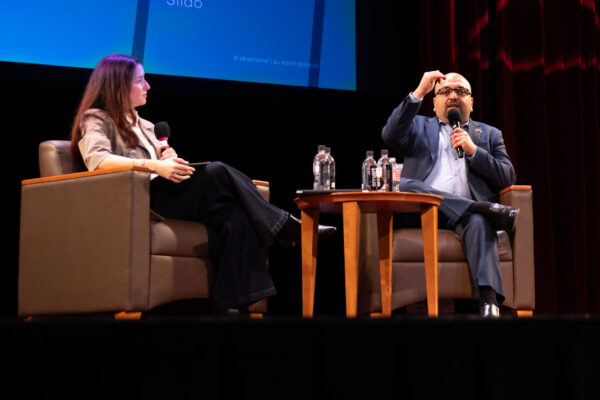Americans continue to fear corruption in government more than anything else, according to the 11th annual Chapman University Survey of American Fears, released today by Chapman University.
The nationally representative survey conducted by Wilkinson College of Arts, Humanities, and Social Sciences provides an in-depth look at the most common fears across the country and explores how those anxieties shape daily life, decision-making, and emotional well-being.

For the tenth consecutive year, corrupt government officials topped the list, with 69% of respondents saying they are afraid or very afraid of government corruption. Other leading fears include a loved one becoming seriously ill (58.9%), economic or financial collapse (58.2%), and cyber-terrorism (55.9%).
“Understanding what we’re afraid of isn’t about stoking anxiety, it’s about putting those fears into context,” said Dr. Christopher Bader, Chair and Professor of Sociology at Chapman University and lead researcher on the study. “Often, the events that capture the most media and social media attention are rare and unusual. But because they’re highlighted so vividly and so often, they can feel like daily threats. Recognizing that difference helps us regain perspective and power over our own emotions.”
While many of the nation’s top fears reflect legitimate concerns, the researchers note that perception often outweighs reality. Fear of crime, for example, has increased despite a long-term decline in crime rates. Similarly, concerns about economic collapse and global conflict tend to mirror the tone of political and media discourse rather than statistical data.
“People have greater access to information than ever before, but they’re also more exposed to commentary and imagery designed to evoke emotion,” said Dr. Edward Day, Associate Professor of Sociology at Chapman. “Understanding how fear works helps us distinguish between what feels dangerous and what actually is.”
The survey team, known as Team Fear, draws on decades of social science research to help people manage fear in healthy and productive ways. Among the strategies highlighted in the report are:
- Limiting media exposure to reduce constant exposure to alarming content.
- Facing fears through education and preparation to engage reason over instinct.
- Building community connections to counter isolation, which heightens anxiety.
- Recognizing manipulation in rhetoric or advertising that exploits fear to influence behavior.
“When we step back and understand what’s behind our fears, we can make better decisions, as individuals and as a society,” Dr. Bader said. “Fear can motivate us, but it shouldn’t mislead us.”

Maddie Southern (’26), a Chapman University senior who worked alongside the research team, said she hopes the study helps people feel less isolated in their anxieties.
“I think a lot of people become more fearful because they feel alone,” Southern said. “Seeing that so many others share these fears can build community and resilience, especially during times that are politically and economically challenging.”
The Chapman University Survey of American Fears is conducted annually by Wilkinson College of Arts, Humanities, and Social Sciences in collaboration with the Ludie and David C. Henley Social Sciences Research Laboratory and the Earl Babbie Research Center.
The 2025 survey was conducted by SSRS using a probability-based national sample of 1,015 adults, with a margin of error of ±3.6%.
The full 2025 report, including charts, methodology, and analysis, is available at www.chapman.edu/fearsurvey.




